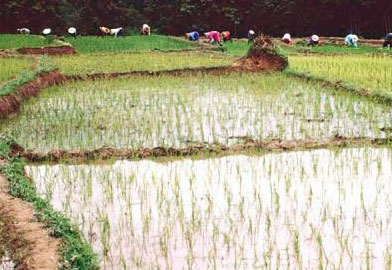Rice and risk of arsenic exposure
The team of scientists working at Dartmouth College of Medicine, Dartmouth College, USA, found that there was a risk of arsenic poisoning when using rice.
The results of this study were published in the Proceedings of the National Academy of Sciences (PNAS).
Arsenic exists naturally in the environment and arsenic (in high concentrations) can be harmful to human health. Arsenic is also present in groundwater. The World Health Organization has established limits for safe arsenic levels in drinking water (10 micrograms per liter of water). Concerns about arsenic exposure are now expanding into rice consumption habits, highlighted in a new publication on the PNAS Proceedings. Rice is susceptible to arsenic contamination, due to its ability to easily extract arsenic from the environment of rice.
"There is a risk of harm to the health of the fetus, when the pregnant mother is exposed to arsenic , " says Margaret Karagas, professor of family and community health care, Dartmouth School of Medicine. United States and the leading author of the study.

Karagas, who is also the director of the center for disease prevention and environmental impact on children's health at Dartmouth, and colleagues have been active in the field of studying the harmful effects of arsenic on children's health. people for more than 15 years. Karagas notes that many other research results also show that the link between arsenic exposure is very high with: high mortality rates in newborns; weight reduction at birth; obstructing immune function and increasing death from lung cancer later.
"This study was conducted to collect urine from 02 groups of women (total of 229 pregnant women): whether or not to eat rice within 2 days before collecting urine; Women's tap water in the home This has also been tested for arsenic concentration , " said Diane Gilbert-Diamond, a postdoctoral fellow and co-author of this study.
Urinary arsenic concentration of 73 pregnant women (who ate rice) was 5.27 micrograms per liter of urine; while urine arsenic concentration of 156 pregnant women (who did not eat rice) was 3.38 micrograms per liter of urine, a statistically significant difference between the two groups of women.
"Currently, China has a statutory limit on the arsenic content of rice (0.15 micrograms of inorganic arsenic per kilogram of feed), but the United States and the EU do not have the same rules. Rice is a source of nutritious food all over the world, but with health risks, people need to consider when consuming rice, " according to researchers.
The authors of the study also concluded that private wells in New Hampshire are a potential source of exposure to arsenic. In this study, more than 10% of women who consumed water contained arsenic concentrations that exceeded the permitted standard as recommended by the World Health Organization (WHO) and the Standard Environmental Protection Agency for public water systems.
"We recommend that all homeowners use private wells, should regularly check arsenic levels in the country," said Kathryn Cottingham, co-author and professor of biological sciences. "Although the health risks of rice consumption are still unclear, the health risks posed by polluted water have long existed."
This research was supported by the Research Program on the Toxic Levels of Metals at Dartmouth, the National Institute of Environmental Health (NIEHS) and the US Environmental Protection Agency (EPA). .
- The cause of arsenic-contaminated rice
- Arsenic can be fatal after 20 years
- Rice soaking overnight helps reduce the risk of toxic chemicals
- Influenza A / H1N1 and its relationship with arsenic exposure at common levels
- HIV exposure and treatment
- India develops arsenic detection techniques
- 20 million Chinese people can poison arsenic
- Hanoi underground water 'arsenic contamination' to foreign newspapers
- How much arsenic in water is dangerous?
- Finding ferns that can live in arsenic-polluted environments
- Drinking dangerous arsenic water like smoking
- Southeast Asia has a high rate of arsenic poisoning in the country
 'Fine laughs' - Scary and painful torture in ancient times
'Fine laughs' - Scary and painful torture in ancient times The sequence of numbers 142857 of the Egyptian pyramids is known as the strangest number in the world - Why?
The sequence of numbers 142857 of the Egyptian pyramids is known as the strangest number in the world - Why? History of the iron
History of the iron What is alum?
What is alum?